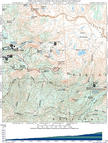
![]()

![]()

![]()

![]()

![]()

![]()

![]()

![]()

![]()

![]()

![]()

![]()

![]()

![]()

![]()

![]()

![]()

![]()

![]()

|
Recommends... The High Sierra: Peaks, Passes, and Trails - by R.J. Secor. Unquestionably the bible of California backcountry adventure. Reliable and exhaustive, which is no small feat, given the scale of the "Range of Light". |
| Selected Photos... |
 Alta Peak
Alta Peak

|
| Summary | Image Gallery | Trip Map
|
|
|  Click Here  Click Here |
|
|
Upon reaching the summit, an incredible panoramic view opens up, especially to the southeast. Countless jagged peaks, belonging to the Great Western Divide, Kaweah Peaks, and probably some along the Sierra Crest. The slopes to the south drop away over 6000 feet into the drainage of the Kaweah River. The usual haze makes for strange views to the south and west. For some reason, the haze is quite photogenic. To the north, you can see Pear Lake, the site of a backcountry ranger station. Tokopah Valley, in my opinion, is one of the prime examples of glacial geology in California. If you go to the ridgeline west of the summit, you can see also Emerald Lake and the arete that separates it from Pear Lake, as well as the fantastic glacial headwall above Emerald Lake. Tharps Rock breaks up the hazy monotony of the view to the southwest. This rock horn appears to offer at least some challenging scrambling, and possibly a technical climb, up its north ridge. Tharps Rock blocks the view of Alta Peak itself from the Alta Meadow/Alta Peak trail split, although it is some 600 feet lower than Alta.
Alta Peak's slopes contain a few classic backcountry ski descents. It is rare to find long, constant, open slopes that are high enough to contain big snow and close enough to a plowed road for easy access. Starting from the ridgeline northeast of Alta, you can make a big 2200-foot descent to Alta Meadow. Horizontal distance is around 0.85 miles, for a sustained slope angle of over 25 degrees--perfect for an intermediate backcountry hacker like me, but not in the middle of the "magic" avalanche range of 25-40 degrees. Since the Pear Lake ranger station, a common winter backcountry outpost, sits only a mile north of Alta Peak, it is common to climb up to Alta's northeast ridge and ski back down various routes.
Kim and I climbed Alta on October 28, 2001, a perfect (if a bit smoky) cool fall day, and
most importantly, one day before the year's first winter storm! We started at Wolverton
around 11 a.m. and hiked quickly, reaching the summit at 2 p.m. with a few brief stops.
We farted around on top, eating lunch and taking pictures. When we stepped off the summit
at 2:45, we immediately realized that due to reversion to standard time, darkness would
fall by 5:30 at the very latest. So we busted our butts back and reached the truck at
around 5:05 p.m. So it is possible to cram this one into a half day, but you should
probably bank on 7 hours or more for a round trip.
|
Department of Geophysics Stanford University |

|